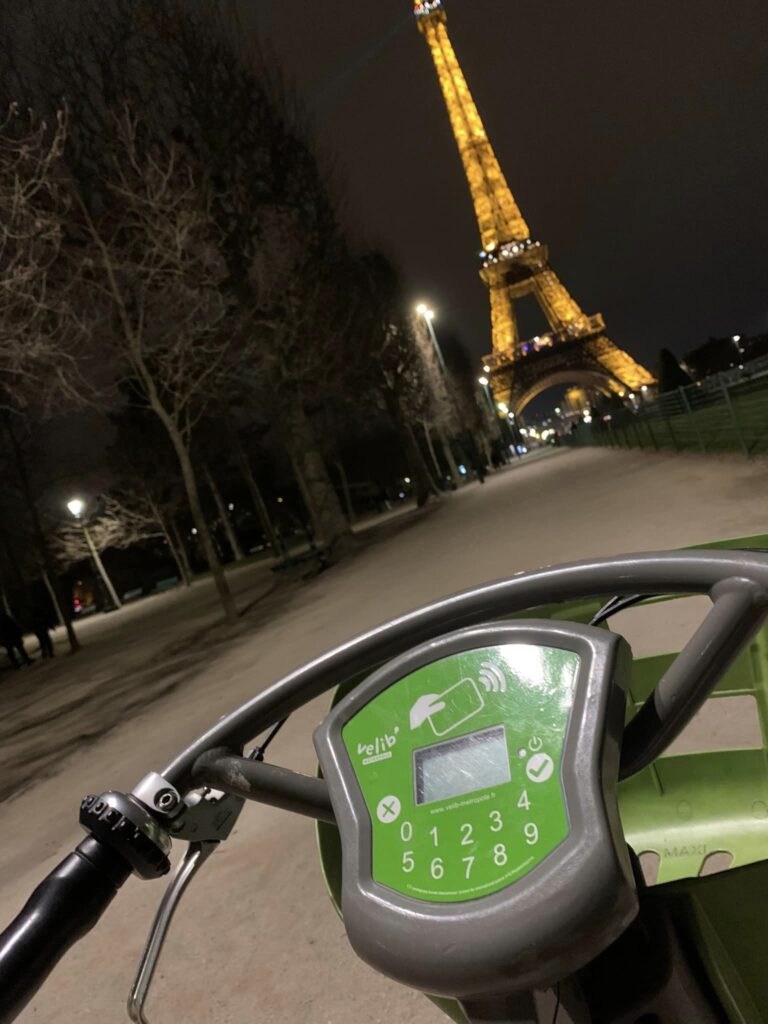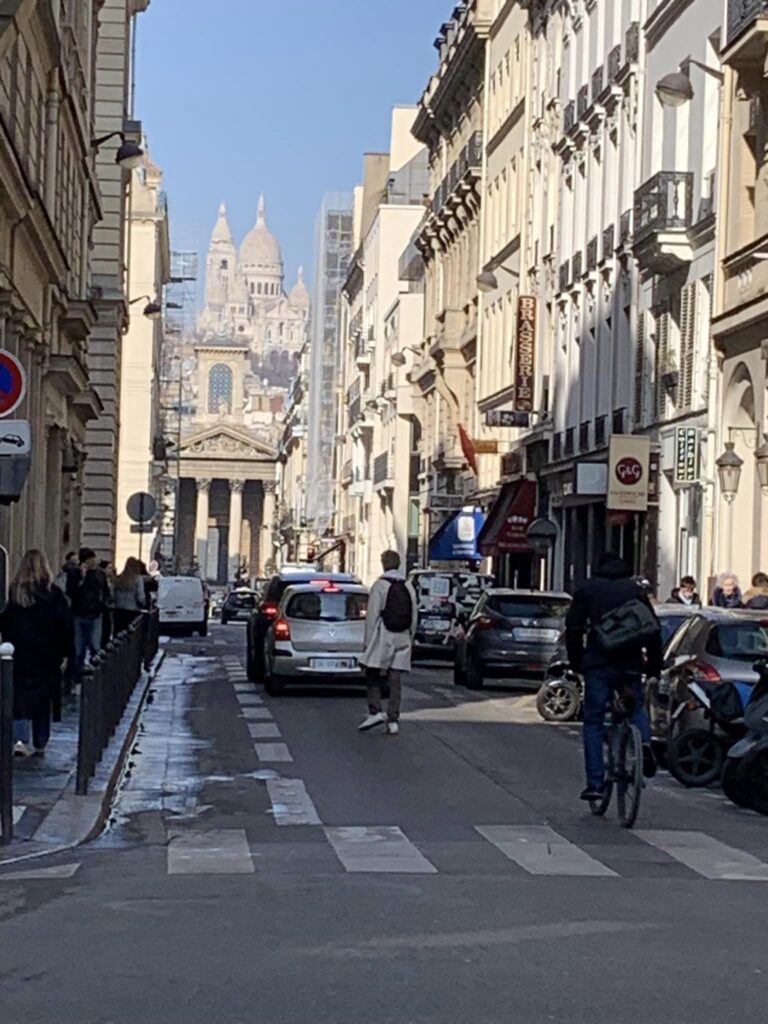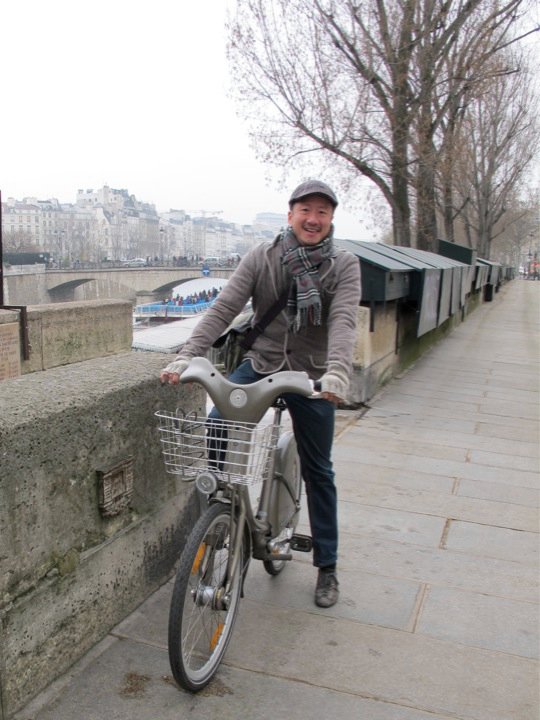 Because I’ve been lucky enough to live in Paris twice – four months in 2014 to 2015 and three months in early 2016 – I am sometimes asked for advice. And I freely give it. From my Dad, when I was growing up, I learned a restaurant or business should come recommended. The best advice would often come from someone you know.
Because I’ve been lucky enough to live in Paris twice – four months in 2014 to 2015 and three months in early 2016 – I am sometimes asked for advice. And I freely give it. From my Dad, when I was growing up, I learned a restaurant or business should come recommended. The best advice would often come from someone you know.
When I started travelling the world, it was in the age of the travel guides: Let’s Go! and others. They were all about someone who had inside knowledge and experience passing it on to the hundreds or thousands of people who were reading the book! I’ve often searched long and hard for a particular cafe or tourist destination, determined to follow advice I’d received from a friend, or a friend of a friend, or from an article in the New York Times.
 So my first advice about Paris may seem counter-intuitive. The thing is, in my experience, so many people have been to Paris and love Paris, that they will offer advice, a lot of it, about their absolutely MUST-do activities. And the truth is: Paris will be magical, and will be yours, so my first advice is not to worry about taking everyone’s advice. Including mine. If something catches your interest, it can be a fun adventure to seek it out. I often build my travel around various missions: certain restaurants or treats or a tour of used designer clothes stores. But cities will offer you their own gifts, especially Paris.
So my first advice about Paris may seem counter-intuitive. The thing is, in my experience, so many people have been to Paris and love Paris, that they will offer advice, a lot of it, about their absolutely MUST-do activities. And the truth is: Paris will be magical, and will be yours, so my first advice is not to worry about taking everyone’s advice. Including mine. If something catches your interest, it can be a fun adventure to seek it out. I often build my travel around various missions: certain restaurants or treats or a tour of used designer clothes stores. But cities will offer you their own gifts, especially Paris.
 I’m a particular fan of the almost-free bike system in cities like Paris. It is astonishing that you can ride around freely, often in wide bike lanes, but even in traffic, it seems like Paris drivers are so used to chaos, and cyclists, and pedestrians, that you should feel safe and easy. These days I think you need to download their app, and use their app, and you can rent cycles for single trips, or for a day, or with some difficulty for three days at a time. I love riding on a Vélib in Paris. I feel utterly free. Exhilarated. Getting lost is part of the fun.
I’m a particular fan of the almost-free bike system in cities like Paris. It is astonishing that you can ride around freely, often in wide bike lanes, but even in traffic, it seems like Paris drivers are so used to chaos, and cyclists, and pedestrians, that you should feel safe and easy. These days I think you need to download their app, and use their app, and you can rent cycles for single trips, or for a day, or with some difficulty for three days at a time. I love riding on a Vélib in Paris. I feel utterly free. Exhilarated. Getting lost is part of the fun.
If you don’t have time or choose not to do the Louvre, the Musée d’Orsay is wonderful. In that whole area, on the lovely bridges and river, when the gypsies throw rings at you, or ask if you lost it and thrust it in your hand, return it and ignore them. Similarly, if you’re up at Sacre Coeur (I love the church and the view is wonderful, though during the day, it’s a bit touristy and the shops are terrible), when the African string men try to tie string around the wrists of you or your party, politely refuse and move on. But don’t get aggressive with them, as that’s their aim.
 I think it’s a lovely thing to go to a humble French restaurant, the tables all close together, and the menus all nearly the same. Tripadvisor or Google Maps will give you reviews for ones near where you’re staying. A friend told me in 2023, the new trend is to go to a bouillon, a classic French bistro serving humble food at not high prices. I should have checked them out myself! If you’re in the Marais, I really like the restaurant Dessance: it’s very good value for such a gourmet meal, not the top-end of restaurants (which are so expensive) but a treat nonetheless, and you should treat yourselves to AT LEAST one lovely meal while in Paris. You can watch the chefs at work in the open kitchen; the staff are utterly charming, and the food is surprising and delicious and wonderful.
I think it’s a lovely thing to go to a humble French restaurant, the tables all close together, and the menus all nearly the same. Tripadvisor or Google Maps will give you reviews for ones near where you’re staying. A friend told me in 2023, the new trend is to go to a bouillon, a classic French bistro serving humble food at not high prices. I should have checked them out myself! If you’re in the Marais, I really like the restaurant Dessance: it’s very good value for such a gourmet meal, not the top-end of restaurants (which are so expensive) but a treat nonetheless, and you should treat yourselves to AT LEAST one lovely meal while in Paris. You can watch the chefs at work in the open kitchen; the staff are utterly charming, and the food is surprising and delicious and wonderful.
 I also love the Israeli food and falafels in the Jewish streets of the Marais (Rue de Rosier), an ‘ethnic’ break from French food, but really, the only reasonable and nice non-French food in Paris (Asian food was terrible (though perhaps improving?) and other cuisines will be expensive and generic, though Moroccan or Tunisian restaurants can be pretty good. L’As du Falafel is famous.
I also love the Israeli food and falafels in the Jewish streets of the Marais (Rue de Rosier), an ‘ethnic’ break from French food, but really, the only reasonable and nice non-French food in Paris (Asian food was terrible (though perhaps improving?) and other cuisines will be expensive and generic, though Moroccan or Tunisian restaurants can be pretty good. L’As du Falafel is famous.
Do take a break, if you have the time, from restaurants and have a lighter meal at your AirBNB (which I always recommend over hotels in Paris; they’re often very charming, and better value, and located in more interesting locations). Pop into a grocery store (you’ll likely see Monoprix, Franprix and Carrefour) and the cheese will be of such quality and such a bargain, it may make you sad ever after you’ve left France. Maybe some paté campagne? The grocery stores sell liquor and have the most interesting selections of French aperitifs, like Lillet Blanc or Floc de Gascogne. They’ll cost a pittance. Have a little glass to fortify you each evening before you head out for your evening activity.
 I find no greater delight in Paris than the pastries. If you see a sign that says a boulangerie has won a prize for best croissant or baguette, go in and buy one! They’re crazy good. My trip in 2023, I discovered a new pastry, le pain de seigle feuilleté: it’s made from rye flour and tastes like a croissant with many layers but in the form of bread. I chased down mine at Les Copains du Faubourg (as recommended by the New York Times) but the bakery near my AirBNB (La Parisienne St Germain) also had them, so, even though a friend from Paris said she’d never heard of it, maybe it’s a new trend?
I find no greater delight in Paris than the pastries. If you see a sign that says a boulangerie has won a prize for best croissant or baguette, go in and buy one! They’re crazy good. My trip in 2023, I discovered a new pastry, le pain de seigle feuilleté: it’s made from rye flour and tastes like a croissant with many layers but in the form of bread. I chased down mine at Les Copains du Faubourg (as recommended by the New York Times) but the bakery near my AirBNB (La Parisienne St Germain) also had them, so, even though a friend from Paris said she’d never heard of it, maybe it’s a new trend?
 I think it’s really important to try a pastry from a shop that will be glowing and sparkling and looking like they sell jewellery or expensive watches instead of just pastries! Splurge (because when’s the next time you’ll be in Paris?). I am ALWAYS telling my friends to go to Aux Merveilleux de Fred (there are branches all over Paris, look on Google). Based on a traditional recipe from Northern France, they’ve shrunk a cake to individual portions, basically a meringue filled with cream, and covered in chocolate flakes. They’re unbelievable. Don’t go for the small ones: the proportions are wrong. Have a proper big sized one. Please.
I think it’s really important to try a pastry from a shop that will be glowing and sparkling and looking like they sell jewellery or expensive watches instead of just pastries! Splurge (because when’s the next time you’ll be in Paris?). I am ALWAYS telling my friends to go to Aux Merveilleux de Fred (there are branches all over Paris, look on Google). Based on a traditional recipe from Northern France, they’ve shrunk a cake to individual portions, basically a meringue filled with cream, and covered in chocolate flakes. They’re unbelievable. Don’t go for the small ones: the proportions are wrong. Have a proper big sized one. Please.
 Still, there are astonishing pastry shops on Rue du Bac, and all over Paris. Macarons were a bit thing for a period, especially from Ladurée and Pierre Hermé, and I mean, you should certainly try one, but do also try a fancier pastry. Or two. Or three. On my last trip, I discovered the Pierre Hermé are also renowned for their pastries, in additions to their macarons. I tried two varieties, and my god, they were incredible. Actually, as weight control, I skipped lunch one day … and had a pastry instead. The description on this one said: The 2000 feuilles presents a harmony of textures: caramelized puff pastry and crushed hazelnuts contrast with the creaminess of its praline mousseline cream.
Still, there are astonishing pastry shops on Rue du Bac, and all over Paris. Macarons were a bit thing for a period, especially from Ladurée and Pierre Hermé, and I mean, you should certainly try one, but do also try a fancier pastry. Or two. Or three. On my last trip, I discovered the Pierre Hermé are also renowned for their pastries, in additions to their macarons. I tried two varieties, and my god, they were incredible. Actually, as weight control, I skipped lunch one day … and had a pastry instead. The description on this one said: The 2000 feuilles presents a harmony of textures: caramelized puff pastry and crushed hazelnuts contrast with the creaminess of its praline mousseline cream.
 A favourite meal in Paris is a hole in the wall (the space is literally called ‘Le trou dans le mur’) where the wall happens to be the back of a really great wine shop, La Cave des Abbesses (it’s below Sacre Coeur, not far from Montmartre). You order une planche (a platter, a plank?) of cheese and meat, and my god, it’s the best cheese and charcuterie EVER. Wash it down with aperitifs or a wide selection of reasonably priced French wine. I can’t recommend this enough.
A favourite meal in Paris is a hole in the wall (the space is literally called ‘Le trou dans le mur’) where the wall happens to be the back of a really great wine shop, La Cave des Abbesses (it’s below Sacre Coeur, not far from Montmartre). You order une planche (a platter, a plank?) of cheese and meat, and my god, it’s the best cheese and charcuterie EVER. Wash it down with aperitifs or a wide selection of reasonably priced French wine. I can’t recommend this enough.
I also find a wonderful mystery of Paris is how good the baguettes are. When pondering this, a friend explained that it’s not a surprise that they taste different in Paris than elsewhere, when the flour, yeast, butter and water are ALL different. One of my  favourite Paris food writers, David Lebovitz, recommended a sandwich from Le Petit Vendôme, centrally located a stone’s throw from Opéra. You have to sit at the counter, rather than at a table to order a sandwich, but my god it was good. I’d wager that it was *perfect*.
favourite Paris food writers, David Lebovitz, recommended a sandwich from Le Petit Vendôme, centrally located a stone’s throw from Opéra. You have to sit at the counter, rather than at a table to order a sandwich, but my god it was good. I’d wager that it was *perfect*.
So, you’ve probably gotten the impression that I could go on and on. And I could. The best caramels you’ve ever had in your life, from Jacques Genin. A wander around the food hall at La Grande Épicerie. I myself love to wander slowly around a department store like La Samaritaine or Printemps and see the latest and greatest in fashion (and wonder who can afford to pay $500 for a t-shirt). The best (and most expensive) chocolates you’ve ever tasted, maybe from Paul Roger. I like spending time in some of the beautiful old churches in Paris. I’m not religious but I feel a quiet sense of wonder that I don’t feel in newer churches. But honestly, there is so much you will discover on your own, I should leave you to it! Enjoy and leave comments if you will and what you enjoyed the most. But one last thing … When it gets dark, on the hour, until 11pm, take a stroll somewhere where you have a good view of the Eiffel Tower (from Palais de Tokyo perhaps). You will not be disappointed. I can’t believe I didn’t know about it until …

 Yellowface by Rebecca F. Kuang
Yellowface by Rebecca F. Kuang


 It’s been a long time since I’ve done a blog post on a restaurant, but for Dessance, I’ll make an exception. With so many exceptional restaurants in Paris, I always recommend that
It’s been a long time since I’ve done a blog post on a restaurant, but for Dessance, I’ll make an exception. With so many exceptional restaurants in Paris, I always recommend that  friends treat themselves to at least one very special meal while visiting (if not more!). When I had the opportunity to be in Paris in March 2023, I decided that Dessance would be my choice.
friends treat themselves to at least one very special meal while visiting (if not more!). When I had the opportunity to be in Paris in March 2023, I decided that Dessance would be my choice. But I’m happy to report that Dessance is as good as I remembered. I had a spectacular meal. The service was perfect and charming. They allowed me to try to practice my French and only for a few words did I need to ask for a translation.
But I’m happy to report that Dessance is as good as I remembered. I had a spectacular meal. The service was perfect and charming. They allowed me to try to practice my French and only for a few words did I need to ask for a translation.
 tables upstairs in a sort of alcove above the kitchen, and downstairs, there’s a lovely open sense of space with a super-high ceiling. It feels elegant but not stiff.
tables upstairs in a sort of alcove above the kitchen, and downstairs, there’s a lovely open sense of space with a super-high ceiling. It feels elegant but not stiff. carpaccio, with an orange croustillant, a crisp, which was typical of the food here, almost always a textural element added, like roasted buckwheat or quinoa.
carpaccio, with an orange croustillant, a crisp, which was typical of the food here, almost always a textural element added, like roasted buckwheat or quinoa.
 other in a graceful dance, and you can see how the dishes are assembled, and the expertise and artistry involved. Finally, the desserts. Rather than a rich and decadent dessert, say involving chocolate, I found it an interesting choice to serve such light desserts focused on fruit. The kiwi, aloe vera, sorrel and green pepper sorbet was refreshing and surprising. A soup of sorts!
other in a graceful dance, and you can see how the dishes are assembled, and the expertise and artistry involved. Finally, the desserts. Rather than a rich and decadent dessert, say involving chocolate, I found it an interesting choice to serve such light desserts focused on fruit. The kiwi, aloe vera, sorrel and green pepper sorbet was refreshing and surprising. A soup of sorts! fully engaged in tasting and enjoying each dish, sometimes closing my eyes and focusing on what was in my mouth! I enjoyed just soaking in the atmosphere and the experience, and counting myself so lucky to be able to eat such a wonderful meal at a wonderful restaurant in Paris.
fully engaged in tasting and enjoying each dish, sometimes closing my eyes and focusing on what was in my mouth! I enjoyed just soaking in the atmosphere and the experience, and counting myself so lucky to be able to eat such a wonderful meal at a wonderful restaurant in Paris. Because I’ve been lucky enough to live in Paris twice – four months in 2014 to 2015 and three months in early 2016 – I am sometimes asked for advice. And I freely give it. From my Dad, when I was growing up, I learned a restaurant or business should come recommended. The best advice would often come from someone you know.
Because I’ve been lucky enough to live in Paris twice – four months in 2014 to 2015 and three months in early 2016 – I am sometimes asked for advice. And I freely give it. From my Dad, when I was growing up, I learned a restaurant or business should come recommended. The best advice would often come from someone you know. So my first advice about Paris may seem counter-intuitive. The thing is, in my experience, so many people have been to Paris and love Paris, that they will offer advice, a lot of it, about their absolutely MUST-do activities. And the truth is: Paris will be magical, and will be yours, so my first advice is not to worry about taking everyone’s advice. Including mine. If something catches your interest, it can be a fun adventure to seek it out. I often build my travel around various missions: certain restaurants or treats or a tour of used designer clothes stores. But cities will offer you their own gifts, especially Paris.
So my first advice about Paris may seem counter-intuitive. The thing is, in my experience, so many people have been to Paris and love Paris, that they will offer advice, a lot of it, about their absolutely MUST-do activities. And the truth is: Paris will be magical, and will be yours, so my first advice is not to worry about taking everyone’s advice. Including mine. If something catches your interest, it can be a fun adventure to seek it out. I often build my travel around various missions: certain restaurants or treats or a tour of used designer clothes stores. But cities will offer you their own gifts, especially Paris. I’m a particular fan of the almost-free bike system in cities like Paris. It is astonishing that you can ride around freely, often in wide bike lanes, but even in traffic, it seems like Paris drivers are so used to chaos, and cyclists, and pedestrians, that you should feel safe and easy. These days I think you need to download their app, and use their app, and you can rent cycles for single trips, or for a day, or with some difficulty for three days at a time. I love riding on a Vélib in Paris. I feel utterly free. Exhilarated. Getting lost is part of the fun.
I’m a particular fan of the almost-free bike system in cities like Paris. It is astonishing that you can ride around freely, often in wide bike lanes, but even in traffic, it seems like Paris drivers are so used to chaos, and cyclists, and pedestrians, that you should feel safe and easy. These days I think you need to download their app, and use their app, and you can rent cycles for single trips, or for a day, or with some difficulty for three days at a time. I love riding on a Vélib in Paris. I feel utterly free. Exhilarated. Getting lost is part of the fun. I think it’s a lovely thing to go to a humble French restaurant, the tables all close together, and the menus all nearly the same. Tripadvisor or Google Maps will give you reviews for ones near where you’re staying. A friend told me in 2023, the new trend is to go to a bouillon, a classic French bistro serving humble food at not high prices. I should have checked them out myself! If you’re in the Marais, I really like the restaurant Dessance: it’s very good value for such a gourmet meal, not the top-end of restaurants (which are so expensive) but a treat nonetheless, and you should treat yourselves to AT LEAST one lovely meal while in Paris. You can watch the chefs at work in the open kitchen; the staff are utterly charming, and the food is surprising and delicious and wonderful.
I think it’s a lovely thing to go to a humble French restaurant, the tables all close together, and the menus all nearly the same. Tripadvisor or Google Maps will give you reviews for ones near where you’re staying. A friend told me in 2023, the new trend is to go to a bouillon, a classic French bistro serving humble food at not high prices. I should have checked them out myself! If you’re in the Marais, I really like the restaurant Dessance: it’s very good value for such a gourmet meal, not the top-end of restaurants (which are so expensive) but a treat nonetheless, and you should treat yourselves to AT LEAST one lovely meal while in Paris. You can watch the chefs at work in the open kitchen; the staff are utterly charming, and the food is surprising and delicious and wonderful. I also love the Israeli food and falafels in the Jewish streets of the Marais (Rue de Rosier), an ‘ethnic’ break from French food, but really, the only reasonable and nice non-French food in Paris (Asian food was terrible (though perhaps improving?) and other cuisines will be expensive and generic, though Moroccan or Tunisian restaurants can be pretty good. L’As du Falafel is famous.
I also love the Israeli food and falafels in the Jewish streets of the Marais (Rue de Rosier), an ‘ethnic’ break from French food, but really, the only reasonable and nice non-French food in Paris (Asian food was terrible (though perhaps improving?) and other cuisines will be expensive and generic, though Moroccan or Tunisian restaurants can be pretty good. L’As du Falafel is famous. I find no greater delight in Paris than the pastries. If you see a sign that says a boulangerie has won a prize for best croissant or baguette, go in and buy one! They’re crazy good. My trip in 2023, I discovered a new pastry, le pain de seigle feuilleté: it’s made from rye flour and tastes like a croissant with many layers but in the form of bread. I chased down mine at Les Copains du Faubourg (as recommended by the New York Times) but the bakery near my AirBNB (La Parisienne St Germain) also had them, so, even though a friend from Paris said she’d never heard of it, maybe it’s a new trend?
I find no greater delight in Paris than the pastries. If you see a sign that says a boulangerie has won a prize for best croissant or baguette, go in and buy one! They’re crazy good. My trip in 2023, I discovered a new pastry, le pain de seigle feuilleté: it’s made from rye flour and tastes like a croissant with many layers but in the form of bread. I chased down mine at Les Copains du Faubourg (as recommended by the New York Times) but the bakery near my AirBNB (La Parisienne St Germain) also had them, so, even though a friend from Paris said she’d never heard of it, maybe it’s a new trend? I think it’s really important to try a pastry from a shop that will be glowing and sparkling and looking like they sell jewellery or expensive watches instead of just pastries! Splurge (because when’s the next time you’ll be in Paris?). I am ALWAYS telling my friends to go to Aux Merveilleux de Fred (there are branches all over Paris, look on Google). Based on a traditional recipe from Northern France, they’ve shrunk a cake to individual portions, basically a meringue filled with cream, and covered in chocolate flakes. They’re unbelievable. Don’t go for the small ones: the proportions are wrong. Have a proper big sized one. Please.
I think it’s really important to try a pastry from a shop that will be glowing and sparkling and looking like they sell jewellery or expensive watches instead of just pastries! Splurge (because when’s the next time you’ll be in Paris?). I am ALWAYS telling my friends to go to Aux Merveilleux de Fred (there are branches all over Paris, look on Google). Based on a traditional recipe from Northern France, they’ve shrunk a cake to individual portions, basically a meringue filled with cream, and covered in chocolate flakes. They’re unbelievable. Don’t go for the small ones: the proportions are wrong. Have a proper big sized one. Please. Still, there are astonishing pastry shops on Rue du Bac, and all over Paris. Macarons were a bit thing for a period, especially from Ladurée and Pierre Hermé, and I mean, you should certainly try one, but do also try a fancier pastry. Or two. Or three. On my last trip, I discovered the Pierre Hermé are also renowned for their pastries, in additions to their macarons. I tried two varieties, and my god, they were incredible. Actually, as weight control, I skipped lunch one day … and had a pastry instead. The description on this one said: The 2000 feuilles presents a harmony of textures: caramelized puff pastry and crushed hazelnuts contrast with the creaminess of its praline mousseline cream.
Still, there are astonishing pastry shops on Rue du Bac, and all over Paris. Macarons were a bit thing for a period, especially from Ladurée and Pierre Hermé, and I mean, you should certainly try one, but do also try a fancier pastry. Or two. Or three. On my last trip, I discovered the Pierre Hermé are also renowned for their pastries, in additions to their macarons. I tried two varieties, and my god, they were incredible. Actually, as weight control, I skipped lunch one day … and had a pastry instead. The description on this one said: The 2000 feuilles presents a harmony of textures: caramelized puff pastry and crushed hazelnuts contrast with the creaminess of its praline mousseline cream. A favourite meal in Paris is a hole in the wall (the space is literally called ‘Le trou dans le mur’) where the wall happens to be the back of a really great wine shop, La Cave des Abbesses (it’s below Sacre Coeur, not far from Montmartre). You order une planche (a platter, a plank?) of cheese and meat, and my god, it’s the best cheese and charcuterie EVER. Wash it down with aperitifs or a wide selection of reasonably priced French wine. I can’t recommend this enough.
A favourite meal in Paris is a hole in the wall (the space is literally called ‘Le trou dans le mur’) where the wall happens to be the back of a really great wine shop, La Cave des Abbesses (it’s below Sacre Coeur, not far from Montmartre). You order une planche (a platter, a plank?) of cheese and meat, and my god, it’s the best cheese and charcuterie EVER. Wash it down with aperitifs or a wide selection of reasonably priced French wine. I can’t recommend this enough. favourite Paris food writers, David Lebovitz, recommended a sandwich from Le Petit Vendôme, centrally located a stone’s throw from Opéra. You have to sit at the counter, rather than at a table to order a sandwich, but my god it was good. I’d wager that it was *perfect*.
favourite Paris food writers, David Lebovitz, recommended a sandwich from Le Petit Vendôme, centrally located a stone’s throw from Opéra. You have to sit at the counter, rather than at a table to order a sandwich, but my god it was good. I’d wager that it was *perfect*.
